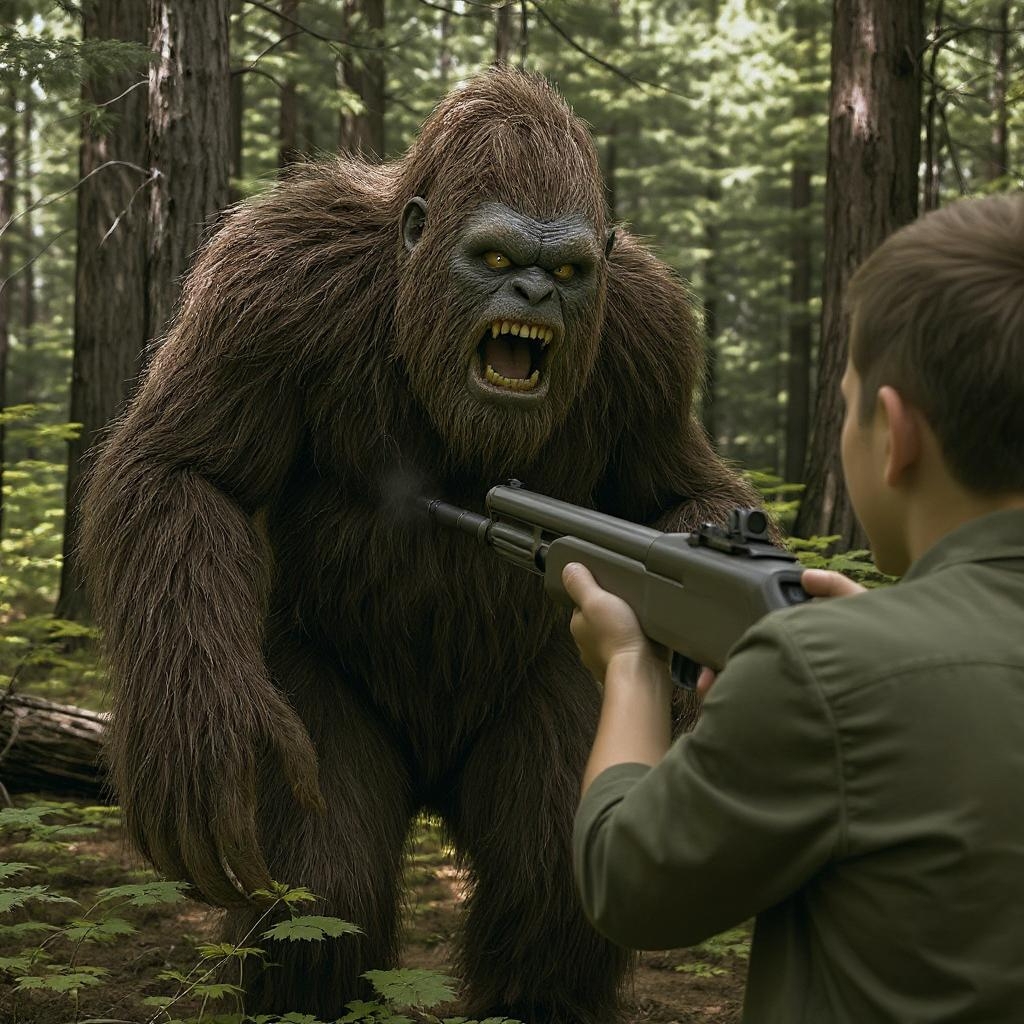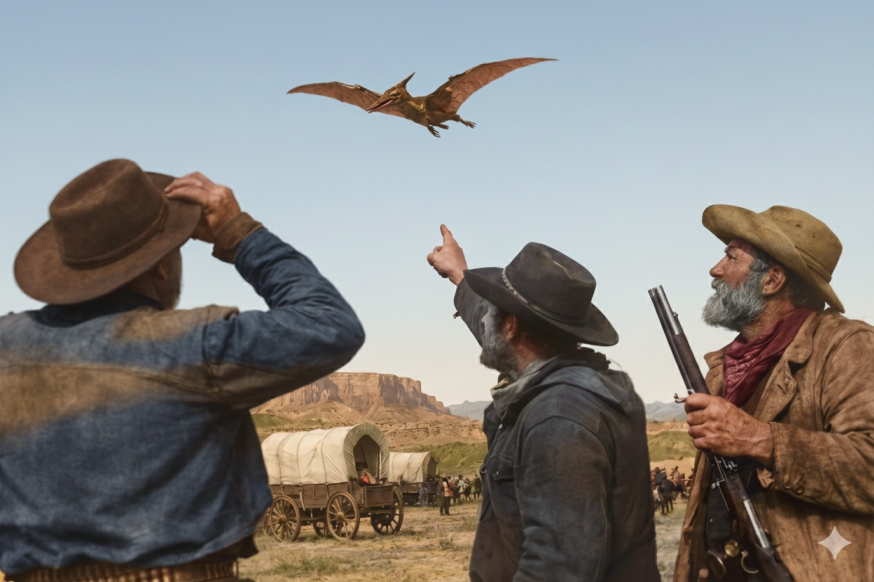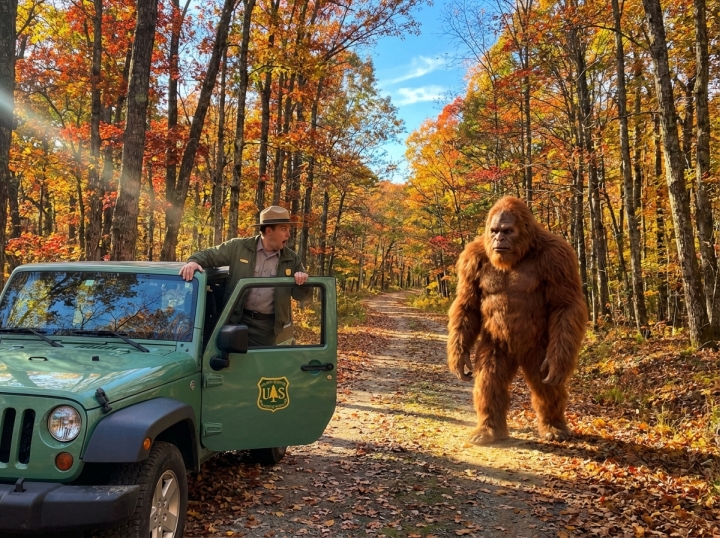Deep within the swamps and bayous of Fouke, in southern Arkansas, a mysterious figure has captured the imaginations of locals and cryptozoologists for over half a century. Known as the Boggy Creek Monster, or the Fouke Monster, this legendary creature has become a permanent fixture in the folklore of the American South. Blurring the lines between myth and reality, the creature’s story gained national attention in the 1970s and has since remained a subject of intrigue, skepticism, and pop culture fascination.
The first major wave of reported sightings began in 1971 in the small town of Fouke, located in Miller County near the Sulphur River Bottoms. Residents claimed that a large, ape-like creature was roaming the woods and creeks near their homes, often at night.
The most famous incident occurred in early May 1971, when the creature allegedly attacked the home of Bobby Ford and Elizabeth(Betty) Ford. According to reports, the beast attempted to break into the Ford house, on the outskrits of Foulke, late at night. Elizabeth claimed she saw a hairy hand reach through the window, and Bobby reported being knocked to the ground by a massive, smelly creature standing over seven feet tall. He fired at it with a shotgun, but the monster escaped into the woods. The area is heavily wooded, interspersed with swampland, creeks (including Boggy Creek), and low-lying river bottoms — an environment well-suited for concealing a large, elusive creature.
Local law enforcement found three-toed tracks near the house, along with scratch marks and damage to the window. The incident was covered by local newspapers and sparked widespread curiosity.
According to the Fords, here is their description of the mysterious beast: approximately seven feet tall, over 250 pounds, covered in dark matted hair or fur, walking upright with a shambling gait like a human, emitting a terrible odor; often compared to a wet dog mixed with a skunk or a decaying animal, possessing long arms and glowing ed or range eyes-depending on the lighting conditions, and making guttural groans or grunts, described as unnatural and terrifying.
The main incident, May 2, 1971, daytime activity: In the days leading up to the encounter, the Ford family and their relatives-who had recently moved into the rented house-reported strange disturbances: Unexplained animal noises at night. Dogs barking frantically. Livestock appearing agitated. Something heavy walking through the surrounding woods. A neighbor, Don Ford (unrelated), had already seen a large, hairy figure near the property days earlier but dismissed it as a bear at first.
The Attack – Night of May 2: Betty Ford was alone in the house while Bobby was out. She heard something scratching at the windows and moving around the porch. When Bobby Ford and his brother Don Ford returned around 10:30 PM, they saw a large, hairy creature fleeing the scene.Shortly afterward, the creature returned. While Bobby was standing on the porch, it reached out from behind and tried to grab him. Bobby broke free and ran inside, visibly terrified and injured. He later appeared at St. Michael Hospital in Texarkana with deep scratches, shock symptoms, and minor injuries. Medical staff reportedly found him to be genuinely frightened and disoriented. No evidence of hallucination, drugs, or alcohol use was found.

Aftermath: The Fouke Constable, Sheriff’s deputies, and local townsfolk launched a search for the creature, but no physical evidence beyond some three-toed tracks and scratched siding on the house were found. Local media covered the event heavily. Soon, curious onlookers, monster hunters, and journalists descended on Fouke.
Notable Details and Context: The Footprints: Three-toed tracks were reportedly found near the Ford house and nearby areas. This footprint shape was unusual, as most primates and North American wildlife have five toes. Casts were made, but no conclusive biological origin was ever confirmed.
Bobby Ford and Betty Ford largely withdrew from the spotlight after the incident and rarely spoke publicly about it afterward.
Over a period of years, other eyewitnesses have provided consistent descriptions of the Boggy Creek Monster: Height: 7 to 8 feet tall . Weight: 250–400 pounds. Hair: Dark brown or black, shaggy and matted. Eyes: Glowing red or yellow in some accounts. Odor: Often described as foul, like rotting flesh Movement: Reportedly agile, swift, and able to navigate thick swamps with ease.
Unlike traditional Bigfoot reports, many sightings include the presence of three-toed footprints, adding a distinct element to the creature’s legend. Skeptics have pointed out that no known primates or mammals leave three-toed tracks, leading some to believe the prints may have been hoaxes. But,these footprints might have been real. Certain forensics will be examined later in this article.
But, there are primates that do leave less than five digit tracks. A spider monkey has four long fingers, no prominent thumb, and five toes. The same thing with a colobus monkey. These two types of monkeys have either absolutely no thumbs or such a small thumb bone that the thumb on both hands appears as practically unnoticeable. But, both these monkeys, not counting their tail size, are only a few feet in length and height. Also, consider sloths, a mainly tree dwelling mammal, like monkeys. that has two long toes, while some sloths have three lengthy toes. While not primates, sloths are small animals, and share a lot of similarities to monkeys,as being very furry. Thousands of years ago, there were giant sized sloths almost ten feet tall, weighing two to three tons, other sloths were much taller and heavier and lived in a great many places within South America and North America. Were those footprints of the three toed Sasquatch looking-Bigfoot looking creature really those of a living giant ground sloth? There are ancient fossils of giant ground sloths that showed them having three toes so they left behind three toed footprints, which also were found. Plus, giant ground sloths would frequently stand upright, move around somewhat while upward, especially when eating leaves on various tall branches on trees using their forearms for grasping; these hands would have prominent three clawed fingers with two other fingers slightly developed. A hand impression left on things would show three clawed fingers with two other fingers not well formed.
Another consideration is that there is a real possibility that this primate or sasquatch; bigfoot creature ( if it is a primate; a sasquatch; a bigfoot) of boggy creek swampland Arkansas suffers from a extremely rare genetic disorder compared to the regular types of sasquatch; or bigfoot. There are people and animals who were born with only two or three toes that are very long and bulky; looking like ostrich feet. Photograph of such deformities appear on the internet. There is even an African tribe known as the Vadoma, among other names, in Zimbabwe, were some tribal members have two large toes and videos thereof are on Youtube. Such a medical condition is called “ectrodactyly”.
The unusual monster occurrence made local and regional newspaper headlines. The Boggy Creek Monster would have likely remained a regional oddity if not for the 1972 docudrama The Legend of Boggy Creek, directed by Charles B. Pierce. Filmed on a shoestring budget, the movie used local actors and dramatized real witness testimonies. It became an unexpected box office success and a cult classic in the horror genThe film played a critical role in elevating the Fouke Monster to national prominence and is considered one of the earliest examples of “docuhorror” cinema. It inspired sequels and countless documentaries, as well as sparking new waves of reported sightings. The legend quickly grew, blending folklore with ongoing eyewitness reports. The film propelled the Fouke Monster into national pop culture and cryptid lore.




